Kyle Hinton in conversation with Brian Khek
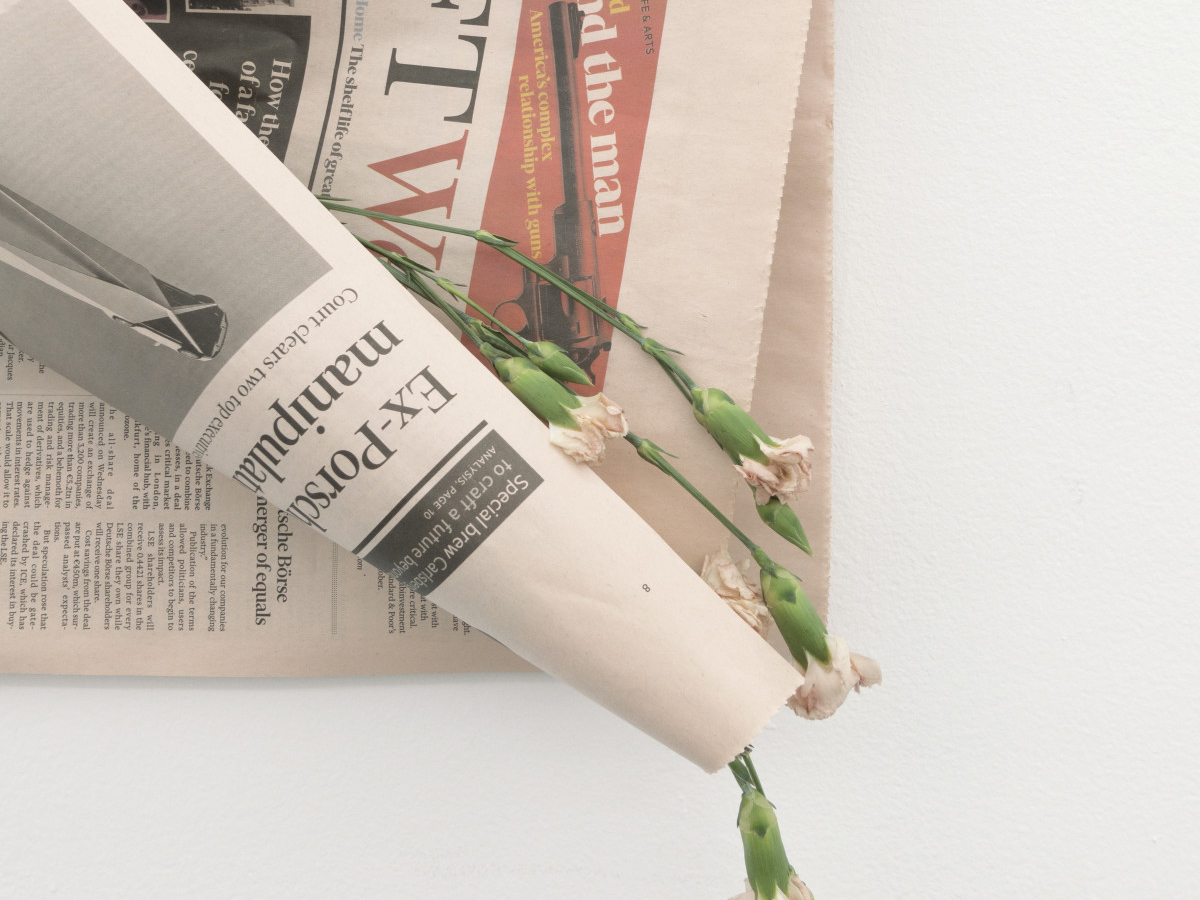
The salmon color of the Financial Times differentiates it from other newspapers. Transpiration makes some of the adorning carnations a similar shade. In the Bed-Stuy gallery overturned umbrellas obstruct a close-reading of what text is visible of the Wall Street Journal; an ad for Louis Vuitton and classifieds for cars has replaced where you would normally read about the primaries. The carnations will lose their color and wilt within a few days, but that’s dictated by a different force.
Kyle Hinton: Most of the materials you use in your work are specific to certain regions and move away from simulation by existing in their natural state. Can you discuss the intent in doing this?
Brian Khek: When I use live materials in their original state, they have a very different politic than a simulated or representational version. Since they are real goods, they have to comply with real trade regulations. The objects begin to have some agency because there are logistics involved with moving them, the same way any person is mediated when crossing borders. This is what lead me to make the Straw Man series.
I’m also complicating the way time is represented in the works. The newspapers are a permanent record while the flowers are immediate—the flowers would wilt and decay over the course of maybe a month. I liked this allegory of buying flowers from wholesale markets or bodegas in newspapers. It’s a portrait of that day.
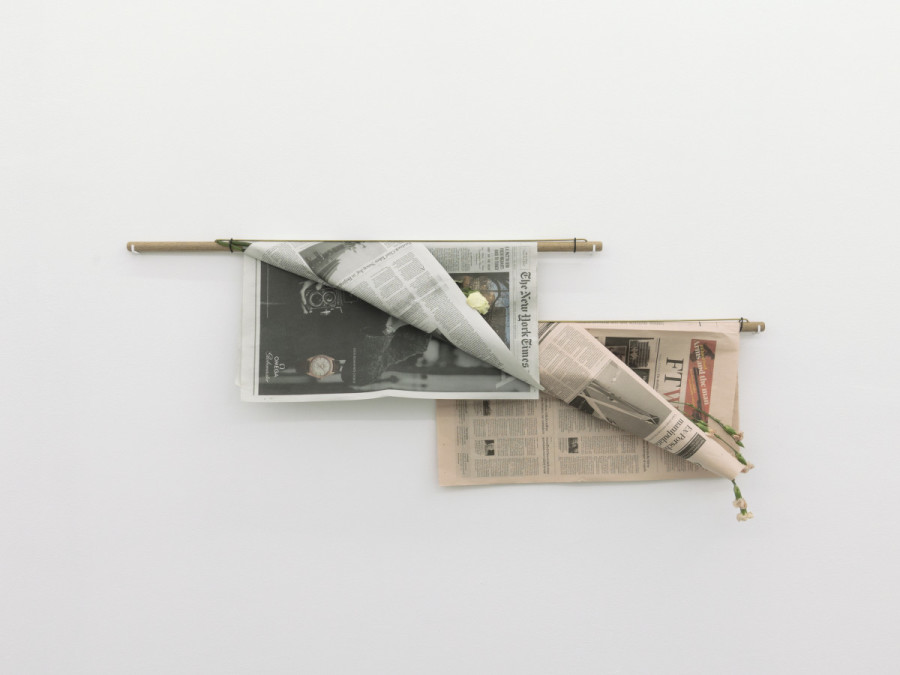 Left to right: Brian Khek, Saturday Newspaper Stick, 2016,newspaper, flowers, oak, brass rod, rubber ring, 36 x 3 x 2 inches. Brian Khek, Sunday Newspaper Stick, 2016, newspaper, flowers, oak, brass rod, rubber ring, 36 x 3 x 2 inches. Images Courtesy of the artist and American Medium.
Left to right: Brian Khek, Saturday Newspaper Stick, 2016,newspaper, flowers, oak, brass rod, rubber ring, 36 x 3 x 2 inches. Brian Khek, Sunday Newspaper Stick, 2016, newspaper, flowers, oak, brass rod, rubber ring, 36 x 3 x 2 inches. Images Courtesy of the artist and American Medium.
KH: Are you framing that complication of time around accelerationism? Jussi Parikka has written about temporalities and how objects degrading or no longer functioning “reveal[s] their essence.” Biohacking and post-human fetish can be opposing tenets; they’re supposed to increase anatomical efficiency with the goal of creating an idealized human laborer.
BK: An important case study for this exhibition was Bertrand Golderg’s Prentice Women’s Hospital. It was constructed in 1975 then demolished in 2014; it was one of the earliest architectural uses of computer-aided design techniques. The hospital was an architectural monument but that land was apparently needed for different medical research. That was a situation where science overruled history. It asks if demolition and rebuilding is the proper evolution for a building.
I guess all innovations are predetermined to be superseded. But I see this cycle complicated by the inherent nature of history. History desires for things to be archived and untouched while science can be indexical in a different way. It’s like the hierarchy of importance is constantly shuffling, just as popular cultural values do. It’s all about how the facts are presented and validated—especially who mediates this information.
KH: The show’s title, Poorly Planned Honor Racks, conveys this idea of information being intentionally withheld by authorities that plan and design cities and public infrastructure. Eyal Weizman said that urban planners develop cities similar to how militaries come to invade them—“both look for ways to control an area by manipulating its infrastructure, reshaping and replacing the built fabric, or attempting to manage the local population’s various cultural sensitivities.” Did you have these ideas about control relative to manipulating information in mind for this show?
BK: I’m interested in how search engines censor information. The aim is to make your results more relevant but this creates what Eli Pariser calls The Filter Bubble. Instead of finding a broad range of information, what you’re seeing is highly biased and catered to you or by the editorial discretion of a third party (your location, browser, etc).
The Straw Man is a projected portrait of a city. It’s an assemblage of different materials collected in that place. This sculpture is a sort of diagram of the Filter Bubble dynamic. Every time the work is assembled, local and readily available materials are sourced. Then it’s packaged into something new—in some ways it’s not generating new ideas, it’s presenting it in a different way. It’s based on a tradition of recycling so it makes sense to use retired clothing and nearby debris. It asks if we need to have access to things outside of our reach. I reference a similar issue in print media in my press release:
It wasn’t until June 17, 1988 that an ordinance allowing newspaper rack placement at the discretion of the mayor in Ohio was overturned by the United State Supreme Court in a 4-3 ruling. It cited that the ordinance could potentially be used to penalize newspapers that criticize the local government.
An ongoing issue we have with technology is privilege and agency—deciding who has access to information and who is censoring information. I wanted to illustrate that problem with the works in a familiar way. The floor sculptures are arranged precariously and block your footing to some of the newspaper sticks and only certain pages of the newspapers are visible at my discretion. Some of the newspaper sticks reveal front page events like the attacks in Brussels while others are flooded with used car classifieds or wrist-watch advertisements.
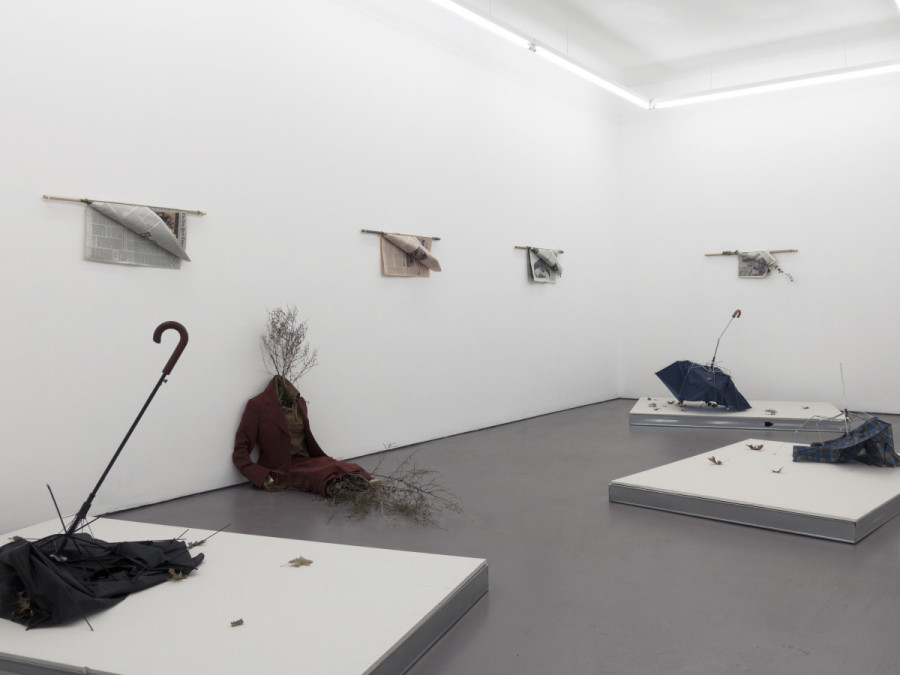 Installation view of Poorly Planned Honor Racks, March 15–April 30, 2016 at American Medium, courtesy of Brian Khek and American Medium.
Installation view of Poorly Planned Honor Racks, March 15–April 30, 2016 at American Medium, courtesy of Brian Khek and American Medium.
KH: The Straw Man figure has appeared twice before in your past shows at Levy Delval and Martos Gallery, both versions dressed in men’s business suits. The iteration in this show depicted the figure in women’s business clothes, stuffed with brush and crumpled phonebook pages. How did you want this conversation to be different?
BK: There were a lot of formats and archetypes that I questioned while working on this piece. I wanted the series to introduce itself with the familiar; the lexicon of a straw man. I referred to political cartoons and film for direction. I see this work evolving with a heavier comment on labor and representation of gender in the workplace. This is what lead to representing a woman. I want this series to be gender equal but complicated by the pacing—man, man, woman, woman, man, woman, and man.
I’m also trying to create a visual allegory of the linguistic definition of a straw man: a case built to prove a point. The materials are chosen based on projections of city it’s shown in. I also lean on sourcing materials that are as close and common to the place it’s exhibited too (this is also true with the umbrellas, newspapers, and flowers). After the work is completed it acts as a materialized conjecture; a speculative representation of a place.
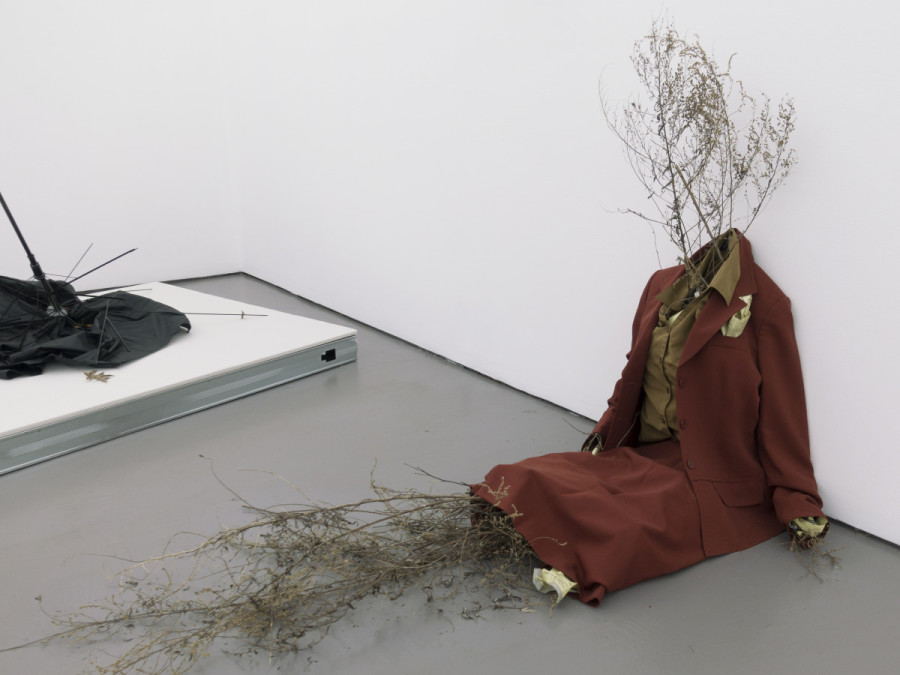 Brian Khek, Straw Man (Brooklyn), 2016, skirt suit, blouse, mares tail, wood, telephone book pages, 42 x 60 x 47 inches, courtesy of the artist and American Medium.
Brian Khek, Straw Man (Brooklyn), 2016, skirt suit, blouse, mares tail, wood, telephone book pages, 42 x 60 x 47 inches, courtesy of the artist and American Medium.
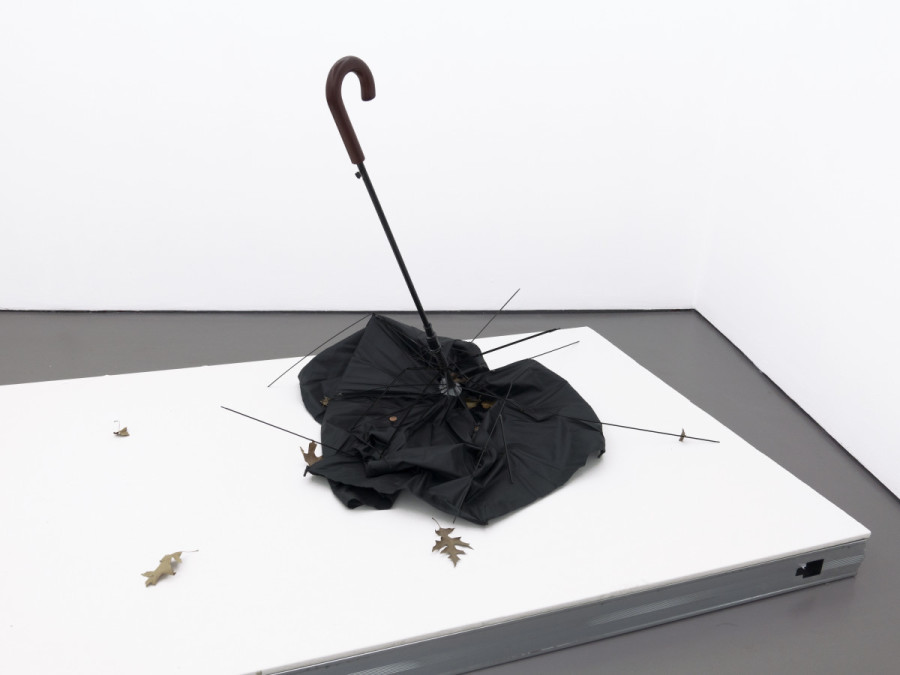 Brian Khek, Abandoned Umbrella: 2, 2016, umbrella, drywall, aluminum studs, leaves, water, pennies, courtesy of the artist and American Medium.
Brian Khek, Abandoned Umbrella: 2, 2016, umbrella, drywall, aluminum studs, leaves, water, pennies, courtesy of the artist and American Medium.
KH: Governments that have jurisdiction over their country’s art markets have made attempts at preserving a national culture or isolating themselves from Western influence (Germany’s cultural protection acts and the Chinese government’s oversight come to mind, respectively). These types of legislation have proven to be extremely polarizing and it leaves some artists frustrated about access to participate in a global discourse and market.
BK: Yeah, the idea of a national treasure can be strange. The provenance of Sir Elgin’s marbles is interesting. There’s this colonialist gesture and then there’s the post-modern facet of that act of colonization, which is now valid to preserve. I experienced some issues in this first hand when I did some work for UCLA’s Fowler Museum. I would help prepare culturally historic images for exhibition and take lots of diligence into each manipulation I made—things like removing fingerprints, balancing colors, etc. The goal was to make the images more legible while respecting the condition of the photos or slides—the culture of preservation in itself was something that needed to be protected too. Of course originals were kept but it’s interesting to see how much of the image was changed at my discretion or by the direction of the curator.
So many political variables like an artist’s citizenship come into play when representing national values. There’s a constant tension between the historical projection of the country’s image versus the privileges that decide how this image evolves.
KH: The current market reifies and demands that individuals possess a hyper-entrepreneurial spirit or be subject to immiseration and its subsequent affects. In the accompanying text it said, “I like to think that I’m in control of my time or relationship to a larger network.” Was this addressing an anxiety related to that labor demand?
BK: That was my response to problematic labor systems that are returning with share economies. I’m not opposed to these things ecologically or ideologically but it breeds a community of marginalized workers. Contract workers are treated like full-time employees without the same benefits or pay. It doesn’t offer many other options than competing for work—this makes sense for some industries but shouldn’t be applied to everything. Now we’re seeing a Uber-ization of all labor communities and it isn’t working.
The freelance/contract model has always been available but now there’s a huge culture exploiting that system. In some ways it’s destroying the 8 hour work day, something that Chicago fought so hard for in the Haymarket Riots. The exhibition actually closed April 30th so it took the day off for May Day.
Brian Khek (b.1989 Chicago, IL) lives and works in Los Angeles. He received a BFA with an Emphasis on Art History, Theory, and Criticism from the School of the Art Institute of Chicago. His work responds to time, regionalism, and technology. Khek has recently shown at Levy Delval (Brussels, BE), Shoot the Lobster (New York City, NY), and Martos Gallery (Los Angeles, CA). Presentations and panels include the introductory 89plus panel at the DLD—Digital, Life, and Design conference in Munich—held in 2013, organized by Hans Ulrich Obrist and Simon Castets. Another panel conversation in the 89plus series, moderated by K-Hole, took place at Art Basel Miami Basel 2013. Khek is also a member of the collective Miami-Dutch.
References
1 https://jussiparikka.net/2012/11/19/downtime/
2 Goldberg, Geoffrey (2012-09-05) “Let’s Save an Architectural Gem That Also Pioneered Engineering”.Engineering News Record online. Retrieved 2012-09-09.
3 http://www.metamute.org/editorial/articles/military-operations-urban-planning
4 http://www.nytimes.com/1988/06/18/us/supremecourtrounduplawthatallowedmayorrulenewspaperracks-overturned.html
5 http://www.e-flux.com/journal/from-the-anxiety-of-participation-to-the-process-of-de-internationalization/
6 http://nymag.com/daily/intelligencer/2014/09/silicon-valleys-contract-worker-problem.html
Brian Khek
American Medium
. . . . .
Interview by Kyle Hinton
May, 2016
O Fluxo
